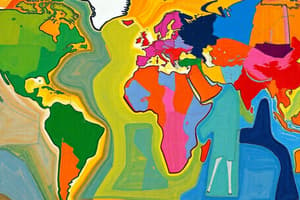Podcast
Questions and Answers
What is the purpose of specialization in international trade?
What is the purpose of specialization in international trade?
To allow countries to produce goods in which they are more competitive and trade with each other.
Which of the following are measures used to restrict international trade? (Select all that apply)
Which of the following are measures used to restrict international trade? (Select all that apply)
- Tax deductions
- Subsidies (correct)
- Quotas (correct)
- Tariffs (correct)
- Exchange controls (correct)
What does the balance of payments register?
What does the balance of payments register?
The international trade transactions of a country over a specific period.
A balance of payments surplus occurs when imports exceed exports.
A balance of payments surplus occurs when imports exceed exports.
The ______ account reflects the flows of money obtained and paid out in exchange for goods and services.
The ______ account reflects the flows of money obtained and paid out in exchange for goods and services.
Which of the following can be corrective actions for balance of payments deficits? (Select all that apply)
Which of the following can be corrective actions for balance of payments deficits? (Select all that apply)
What are floating exchange rates based on?
What are floating exchange rates based on?
Match the following types of exchange rates with their descriptions:
Match the following types of exchange rates with their descriptions:
Changes in exchange rates can impact the costs of imports.
Changes in exchange rates can impact the costs of imports.
Study Notes
Specialization
- Countries should specialize in products where they hold a competitive advantage, leading to more efficient production.
- Country A excels in producing product F, while Country B is better at producing product H.
- Both countries should engage in trade to benefit from each other's specialization.
- Complete specialization is often hindered by strategic considerations.
Restrictions to International Trade
- Governments use various measures to restrict trade:
- Quotas: Limitations on the amount of specific products that can be imported.
- Tariffs: Taxes imposed on imported goods, increasing their cost.
- Exchange Controls: Restrictions on currency purchasing that limit imports.
- Subsidies: Financial support provided to local industries to boost competitiveness and lower production costs.
- Qualitative Controls: Regulations focusing on product quality rather than quantity and price.
Balance of Payments
- The balance of payments records all international trade transactions over a specific period, generally one year.
- It captures monetary flows rather than physical goods exchange.
- Imported goods are recorded negatively (outflow of money), while exported goods are recorded positively (inflow of money).
- Transactions include both current transactions (goods and services) and capital transactions (investment flows).
Current Transactions
- The current account reflects money flows related to exchanged goods and services, encompassing:
- Visible Trade: Import and export of tangible goods.
- Invisible Trade: Import and export of services, which includes banking, hospitality, insurance, and financial transfers.
Capital Transactions
- Capital transactions signify monetary movements across borders for investment.
- They involve both public and private sector funds, with long-term and short-term financial flows.
Equilibrium in the Balance of Payments
- A surplus occurs when export values exceed import values in the current account.
- A deficit arises when imports surpass exports.
- Adjustments in the capital account can offset current account imbalances.
Methods of Correcting Balance of Payments Deficits
- Addressing deficits involves strategies to increase inflow or reduce outflow:
- Decreasing Exchange Rates: Lowers export prices abroad while making imports more expensive.
- Subsidizing Local Companies: Enhances competitiveness of domestic products in foreign markets.
- Implementing Import Controls: Limits foreign goods entering the country.
- Increasing Interest Rates: Attracts foreign investment, counteracting current account deficits.
Exchange Rates
- The exchange rate indicates the value of one currency relative to another, essential for international transactions.
- Currency exchange is necessary for trade; for example, purchasing Omani goods requires converting US Dollars to Omani Riyals.
Types of Exchange Rates
- Floating Exchange Rate: Fluctuates based on market supply and demand without governmental intervention.
- Fixed Exchange Rate: Remains constant, not influenced by market conditions.
- Hybrid Exchange Rate: Blends aspects of both floating and fixed systems.
Exchange Rates and Business
- Changes in exchange rates can impact business dynamics:
- Exports may become more or less competitive based on currency strength.
- Foreign competition may increase or decrease in domestic markets connected to pricing changes.
- Fluctuating exchange rates introduce uncertainty for trading and investment operations.
- Import prices may rise or fall, affecting overall business costs.
Studying That Suits You
Use AI to generate personalized quizzes and flashcards to suit your learning preferences.
Related Documents
Description
Test your understanding of international trade and specialization with this quiz. Learn about the benefits of countries producing goods they are most competitive in.




